Medical expert of the article
New publications
Cervical fluid cytology
Last reviewed: 06.07.2025

All iLive content is medically reviewed or fact checked to ensure as much factual accuracy as possible.
We have strict sourcing guidelines and only link to reputable media sites, academic research institutions and, whenever possible, medically peer reviewed studies. Note that the numbers in parentheses ([1], [2], etc.) are clickable links to these studies.
If you feel that any of our content is inaccurate, out-of-date, or otherwise questionable, please select it and press Ctrl + Enter.
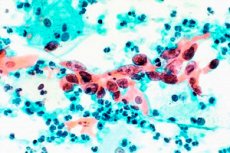
Liquid cytology of the cervix is an innovative method of cytological examination, the "gold standard" for diagnosing neoplasia of the mucous membrane of the canal and the vaginal part of the cervix, which is used when a patient is suspected of having cancer or dysplasia. Thanks to this diagnostic method, cancer can be detected at the earliest stages of development, which increases the chances of a complete cure.
After taking a smear for oncocytology, the biological material is placed in a certain liquid medium. Using a special centrifuge, the cells (cyto-preparations) are "washed", which are concentrated in one place and form an even layer. In this case, the conclusion of the cytologist will be more accurate and informative than with conventional cytology, when the material taken for examination is immediately applied to a medical glass for analysis.
Today, the PAP test technology (ThinPrep) is increasingly used in medicine. The advantage of this innovation is the high clarity of the cell image. When using this technology, the obtained material is mixed with a special solution that mechanically separates the epithelial cells from contaminants. As a result of such a study, the number of false negative responses is significantly reduced.
Indications
Liquid cytology of the cervix as a gynecological method of examination helps in choosing the most effective methods of treating oncological diseases. With the help of this method, it is possible to determine the presence of malignant cells, as well as the degree of development of the disease. Cervical screening is advisable to be carried out at the beginning of sexual activity. Women with the papilloma virus can be included in the risk group.
Indications for the study:
- pregnancy planning;
- disturbances or irregularities of the menstrual cycle (too short or too long a cycle, frequent delays);
- infertility;
- having multiple sexual partners;
- gynecological pathologies of viral etiology ( genital warts, genital herpes, etc.);
- long-term use of contraceptives and hormonal drugs;
- vaginal discharge without cause;
- preparation for the installation of contraceptive devices (intrauterine devices, etc.).
Cervical screening is aimed at diagnosing papillomavirus infection and cervical lesions and taking therapeutic and preventive measures. It is recommended to take a smear in the first week after the end of menstruation. The result may be “normal” (negative), indicating the absence of pathologies in the cervix, and “pathological” (positive) - if atypical cells are detected in the sample, which can subsequently lead to the development of cancer.
Advantages of Liquid Based Cytology
Liquid cytology of the cervix allows obtaining the most accurate result of cell examination for the presence or absence of pathologies.
The advantages of liquid cytology are in the improved quality of the obtained biomaterial. In addition, it should be noted:
- quick preparation of the drug;
- long shelf life and storage of the material (using the PreservCyt stabilizing solution, it is possible to prevent the cells from drying out; this allows the sample to be stored in the most favorable conditions for its subsequent transportation to the medical laboratory);
- the possibility of preparing several cytological preparations from the obtained biomaterial;
- application of standardized staining techniques;
- the possibility of preparing a monolayer smear.

The use of liquid cytology, a new technology for cancer screening, compared to the traditional method, allows for a significant improvement in the quality of the cytological smear, and also provides the opportunity to use additional diagnostic methods without a secondary gynecological examination.
The screening method is recommended to be used with a certain regularity for timely prevention of oncological diseases of the cervix. It allows to detect the initial stages of cancer, as well as precancerous and background processes of the cervical epithelium.
Preparation
Liquid cytology of the cervix is a fast and accessible method of gynecological examination, with the help of which it is possible to obtain accurate information about any deviations in the cells of the cervix. The smear is taken during the examination of the patient in the gynecological chair.
Preparation for this procedure includes refraining from:
- sexual intercourse 2 days before taking the smear;
- vaginal douching (sanitation);
- use of vaginal suppositories and spermicidal ointments;
- taking contraceptives and anti-inflammatory drugs (pills);
- insertion of tampons into the vagina.
It should be emphasized that the liquid cytology test is one of the most informative. The smear is taken quickly and painlessly - this method of examination is widely used in gynecology. You should refrain from urinating 2-3 hours before the PAP test. You cannot do the test during menstruation, with vaginal discharge, itching, or the presence of an inflammatory process.
The procedure itself is very simple: the gynecologist cleans the cervix with a cotton swab, and then uses a special brush to collect material for analysis and apply it to medical glass. After this, a laboratory study of the contents is carried out under a microscope. The results of the analysis can be found out in about 7-10 days. A cytological smear allows you to determine the shape, size, and order of cell placement, which helps diagnose cervical diseases, including cancerous and precancerous conditions. This examination is recommended at least once a year.
Liquid cytology equipment
Liquid cytology of the cervix is an innovative examination method that allows for accurate diagnosis of a vaginal smear in order to detect cancer. The PAP test was introduced into medicine by the Greek scientist George Papanicolaou and in a short period of time helped to significantly reduce the mortality rate of patients diagnosed with cervical cancer, as well as other pathologies (endometrium, etc.). With the help of this method, it is possible to obtain a prognosis with a higher degree of probability than with a simple cytological analysis.
During the process of taking a smear for oncocytology, the gynecologist uses a specially shaped cytobrush, which is placed together with the biomaterial in a special stabilizing solution. The cells are thus completely preserved, which guarantees a higher quality, more accurate and reliable result.
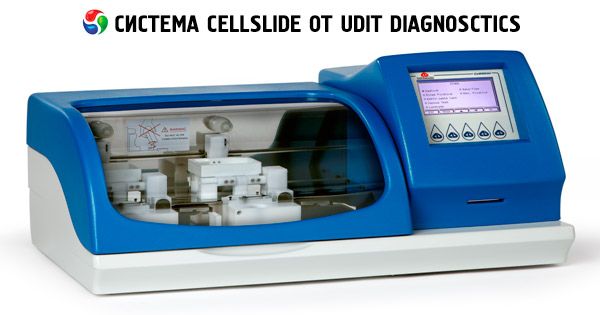
Liquid cytology equipment is an automatic processor that performs operations to produce a cytopreparation using a clearly defined program. The quality of the study is improved by uniform distribution of the cytopreparation on a special glass slide.
A certain volume of biomaterial is used for analysis, after which the cells pass through a vacuum filter, being cleaned of such contaminants as mucus and blood. For further microscopy, a uniform layer of cells is placed on a glass slide. The purified preparation placed on the glass slide ensures higher accuracy of both the research process itself and the result obtained.
It should be emphasized that when using the liquid cytology method, the sensitivity of the test reaches 95%, while with traditional cytological analysis - only 40-60%. According to WHO recommendations, liquid cytology is the "gold standard" of smear testing. High accuracy of the result is achieved by using a combined cytobrush, stabilizing solution and filtration. This allows for timely diagnosis of cervical cancer and the necessary measures for effective treatment.
 [ 13 ]
[ 13 ]
Technique of implementation
Liquid cytology of the cervix is based on a laboratory study of the selected biomaterial. Since cervical cancer develops over a long period of time (several years), regular examination will help to identify the pathology at the early stages of the development of cancer. Thus, the treatment will be more effective.
The technique of liquid cytology is quite simple: the examination is carried out using a gynecological chair. Before the procedure, a gynecological speculum is inserted into the vagina for the purpose of visually examining its canal and cervix. Then the cervix is cleaned of discharge with a cotton swab. Using a sterile cervical brush (endobrush), the gynecologist collects biomaterial (scraping). The sample is placed in a special solution that prevents the cells from drying out, and then spread over the glass. This solution cleans the biomaterials from contaminants (mucus and leukocytes) and preserves the integrity of the epithelial cells. The procedure is absolutely painless and takes little time. The analysis results will be ready in about a week.
Reliable results can only be obtained if the technique for taking a smear is strictly followed. The analysis should be performed no earlier than the fifth day after the onset of the menstrual cycle and no later than the 5th day before the expected onset of menstruation. The result will be unreliable if any medications (suppositories, contraceptives) were inserted into the vagina before the collection of the material, the vagina was sanitized, or sexual intercourse took place 24 hours before the liquid cytology.
Liquid-based PAP cytology
Liquid cytology of the cervix is the most informative method of gynecological examination for the presence of atypical (cancerous) cells. Today, this is a regular test that is carried out during a routine gynecological examination of women.
Liquid Pap cytology (Pap test) is a study of smears (cell samples) taken from the surface of the cervix. This method was discovered in the 1920s by George Papanicolaou, a Greek scientist and physician who, conducting research on rats and making smears with CC, discovered infections and tumors. Thus, the scientist came up with the idea of using this method of cytological diagnostics when examining women. It was officially introduced in 1943.
The test is aimed at early detection and diagnosis of cervical cancer. It is based on the use of a method of staining the samples taken similar to microscopic examination. With the help of staining, it is possible to determine the reaction of cellular structures to basic and acidic dyes. Today, it is practiced throughout the world as one of the main methods of studying oncological diseases.
The smear is collected using an Eyre spatula (a special brush). The samples are transferred to glass, then treated with a fixative solution and sent to a medical laboratory for a thorough examination using staining. This helps to determine reactive, inflammatory, benign or malignant processes. In most cases, the Pap test can identify the slightest pathology of the cervix at the cellular level even before the development of cancer, which allows for timely administration of effective treatment.
Liquid-based cytology smear
Liquid cytology of the cervix is a simple and accurate analysis that can assess the condition of tissues and identify possible pathologies. The procedure is quite safe and relatively painless. The main goal of this study is to identify atypical cells that can eventually degenerate into a cancerous tumor. Timely diagnosis of unfavorable changes and pathologies at the earliest stages will make treatment faster and more effective.
A smear for liquid cytology helps to determine the general condition of the mucous membrane and identify pathology. Today, this method of gynecological examination is considered the most accessible and reliable. With the help of a smear, you can determine the composition of the vaginal microflora, as well as the degree of its purity. To obtain the most accurate result about the condition of the cervix, the gynecologist can conduct a number of additional tests (colposcopy, biopsy).
This test helps to identify viral infections and other factors that can trigger the development of a tumor. A smear is taken with a special brush from three different areas of the vaginal mucosa: from the cervical canal itself, its surface, and the vaults. The samples are immersed in a vial with a solution that prevents the cells from drying out and becoming clogged with bacteria, and then applied to a special glass and sent to a medical laboratory for careful examination. For this purpose, the Papanicolaou staining method is used.
The solution used in cytological examination is resistant to sudden temperature fluctuations and also guarantees long-term storage of cellular material, which makes it possible to conduct additional tests for the entire spectrum of genital infections, including genetic testing for HPV. Thus, the same bottle of liquid cytological material can be used for all studies. In this case, the patient will not need to visit the doctor for additional visits.
Decoding the results
Liquid cytology of the cervix is the simplest and most reliable method of gynecological examination, allowing to identify various pathologies, including cancer in the early stages of development.
The decoding of the results of this cytological study is aimed at assessing the condition of epithelial cells. In total, 5 conditions (stages of development, classes) of the disease are distinguished:
- 1 – there are no pathological disturbances in the structure of cells, normal;
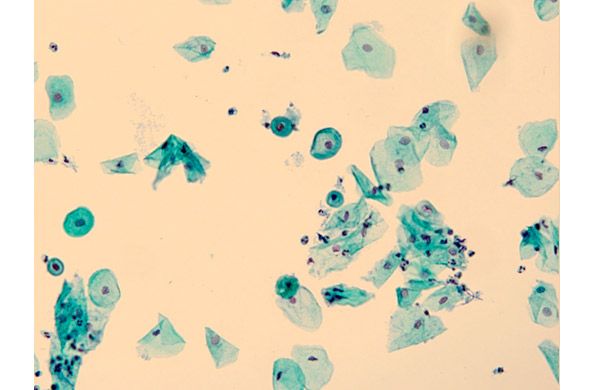
- 2 – a decrease in the morphological norm of some cellular elements is observed; suspicion of inflammation or an infectious disease (for example, vaginosis); for a more accurate diagnosis and treatment, additional examination methods will be needed – colposcopy and/or biopsy;
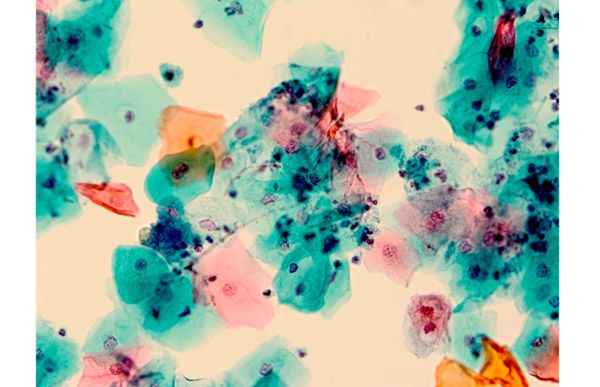
- 3 – abnormal changes are observed in individual cells; repeat examination is necessary;
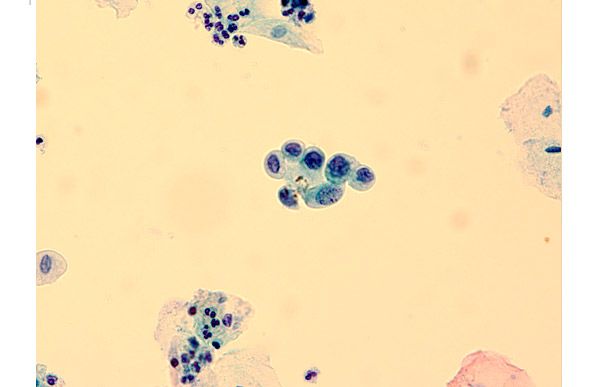
- 4 – malignant changes in the structure of cells that indicate a precancerous condition;
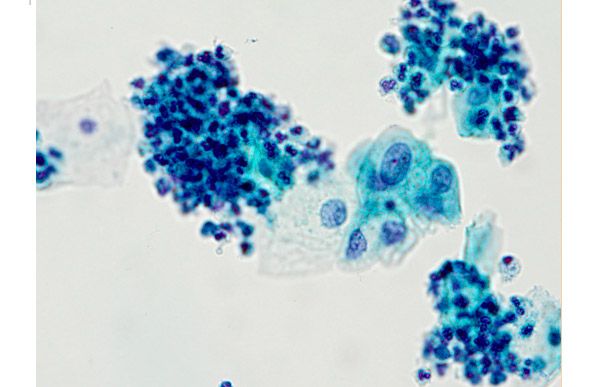
- 5 – a large number of atypical cells were detected, indicating the initial stage of cancer development.
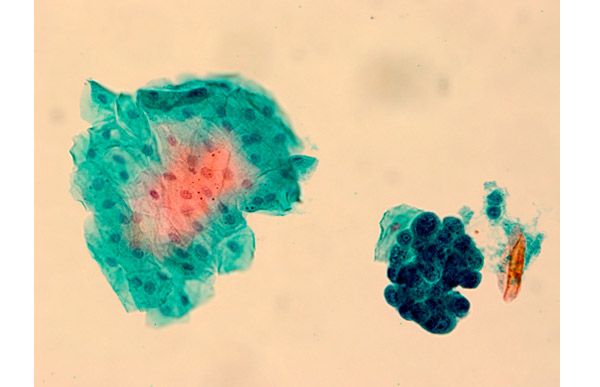
To obtain the most accurate results, the analysis is decoded using the Bethesda system. The final diagnosis is established based on the information received about changes in the cell nucleus and the location of the cells. CBO is an abbreviation indicating the norm of all indicators.
The following abbreviations are used in the interpretation of test results to indicate various pathological changes:
- ASC-US – changes in flat epithelial cells are observed; this indicator is often found in women over 45 years of age due to a decrease in estrogen levels;
- AGC – altered columnar cells were detected, which is an indicator of inflammatory diseases (eg, vaginosis);
- LSIL – there is a small percentage of atypical cells of non-cancerous etiology;
- ASC-H – abnormalities in the cellular structure were detected, indicating a precancerous condition (dysplasia) or an early stage of cancer development;
- HSIL – this abbreviation indicates oncocytology, which is confirmed by the presence of altered flat cells in the sample;
- AIS – the presence of columnar epithelial cells in the smear, which indicates cancer.
 [ 14 ], [ 15 ], [ 16 ], [ 17 ], [ 18 ], [ 19 ], [ 20 ], [ 21 ], [ 22 ]
[ 14 ], [ 15 ], [ 16 ], [ 17 ], [ 18 ], [ 19 ], [ 20 ], [ 21 ], [ 22 ]
Complications
Liquid cytology of the cervix is a painless and simple procedure. At the same time, it gives the most informative result about the presence or absence of any pathologies. This is an effective method for diagnosing cervical cancer at the early stages of the disease. Taking a smear for oncocytology should be done by a specialist doctor who is proficient in the technique of this process.
Complications after the examination usually do not arise. In some cases, only slight bloody discharge from the vagina may be observed, which passes in 2-3 days and does not require special treatment. After manipulations, severe pain may also occur. Such symptoms are considered normal, but if they are accompanied by other signs (fever, chills, severe pain), you should consult a doctor.
If the smear is taken incorrectly, dangerous consequences may arise. Thus, rough intervention provokes the development of stenosis as a result of the formation of adhesions. Therefore, it is not customary to take a smear for cytology in deep areas of the cervical canal. To avoid any complications, a woman is recommended to abstain from sexual relations, the use of tampons and vaginal douching for 7-10 days after the PAP test.
 [ 23 ], [ 24 ], [ 25 ], [ 26 ]
[ 23 ], [ 24 ], [ 25 ], [ 26 ]
Discharge after liquid cytology
Liquid cytology of the cervix is an effective method used in gynecology to detect pathologies associated with inflammatory or infectious diseases, as well as the development of cancer. The procedure is usually painless and does not cause any inconvenience to the woman.
Discharge after liquid cytology may be observed for approximately 5-7 days after the test. Most often, it has a dark brown or dirty green tint. This is normal, so no special treatment is required. During this period, it is recommended to use regular sanitary pads.
If a woman complains of heavy bloody discharge and severe pain after taking a smear, most likely the technique of collecting cytological material was violated. In this case, it is necessary to consult a doctor to prevent possible complications, of which one can note stenosis of the canal caused by adhesions. Such a complication is possible with rough intervention in the cervical canal area.
It is necessary to monitor the condition for several days after this study. If bloody discharge is accompanied by fever, chills, abdominal pain, you should seek medical help as soon as possible.
Liquid cytology of the cervix is considered the "gold standard" of research aimed at timely diagnosis of oncological diseases. With the help of this gynecological method, it is possible to detect precancerous conditions, as well as malignant changes at early stages. In addition to cellular abnormalities, a cervical smear makes it possible to "determine" the presence of pathogenic microorganisms, sexually transmitted infections, viruses and assess the condition of the mucous membrane. Every woman should remember the importance and necessity of regular (annual) examination.

